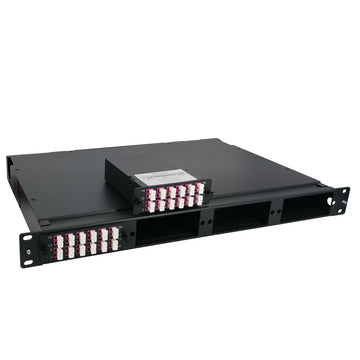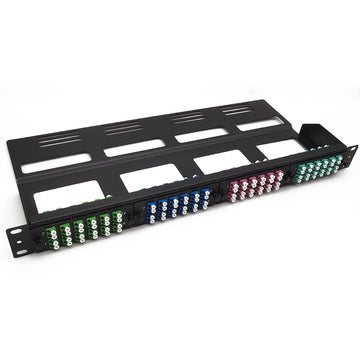How to choose Fiber Patch Panels?
How to choose Fiber Patch Panels?
Fiber patch panel, also called fiber enclosure, is used as a cost-effective method of fiber optic cable management and maintenance in today’s data center. With a fiber patch panel, installers can quickly do the cabling just by making changes to cables on the patch panel itself. What’s more, the patch panel also allows for easier cable management and identification of fiber cable routing. Nowadays, there are various of fiber patch panels on the market. Facing with a dazzling array of options, how to choose the right patch panel for your fiber network?
What are Optic Fiber Optic Patch Panel?
Fiber optic patch panels are also known as fiber distribution panels. They make it easy to terminate fiber optic cables and provide access to the cable’s individual fibers for cross connection.
A basic fiber optic panel is typically a metal enclosure that encloses the adapter panels and fiber splice trays. Splice trays allow fibers to be fused together with fiber optic pigtails which in turn are plugged into the fixed inside ports of the adapter panels.
The inside ports of the panel is usually fixed, meaning that the cables aren’t disconnected at any point. The outside ports of the panel is reserved for fiber patch cables that can be plugged and unplugged frequently to arrange the connections between devices as needed.
The fiber patch panel has two compartments. One contains bulkhead receptacles or adapters, and the other is used for splice trays and excess fiber storage.
The Benefits of Using a Fiber Patch Panel
- All changes are made at one place
Patch panels make it easier to connect different devices in different orders, because all of the changes can be made at the patch panel.
- No more hunting for input ports
A patch panel groups all of the input jacks/ports into one location. This means that devices mounted in racks can be connected without having to hunt around behind the rack or instrument with a flashlight for the right port.
- Saves wear and tear of expensive networking equipment
Using a patch panel also saves wear and tear on the input ports of expensive networking equipment such as servers and switches, because all of the connections are made with the patch panel.
Fiber Patch Panels Types
Port density seems to be a main concern when choosing a fiber patch panel, since the high density is becoming one of an important trends in data centers. At present, a normal 1U fiber patch panel can support up to 48 ports while a high-density patch panel can support up to 96 ports. For MPO/MTP solution, there are ultra density panels which can support up to 144 ports in 1U size. In addition, fiber enclosures with 2U or 4U size can help achieve higher port density, meeting any of your port requirement.
Click on the image to view the product
In general, rack size is used U or RU as its unit. This unit describes the height of equipment designed to mount in a rack. In data centers, the most commonly used rack size is 1U. Additionally, 2U and 4U are also used for high-density applications. In this section, you should choose the proper size depending on your preferred working place of the panels.
When choosing a fiber patch panel, you will meet another parameters, such as loaded patch panel or unloaded patch panel. The loaded patch panel means that the patch panel is loaded with adapter panels, or cassettes sometimes. In data center applications, the most widely used adapter panels are equipped with LC and MTP adapters. Contrary to loaded fiber patch panel is the unloaded patch panel. For unloaded fiber patch panel, users should select cassettes and/or adapter panels according to their fiber connector type or use a splice tray for single- and mass-fusing. The unloaded fiber patch panel is more flexible than the loaded one, but may need an extra purchase for the accessories.
Are You Upgrading to 40/100G?
If you are going to upgrade your network from the existing 10G infrastructure to high-speed 40/100G network, the MPO/MTP breakout patch panel solution may be an ideal choice for you.
With LC adapter panels loaded in the front panel and MPO/MTP adapter(s) loaded in the rear panel, the MPO/MTP breakout patch panels offer a high density, flexible architecture, and high efficiency solution for your migration plan.
In addition, MPO/MTP cassette is also a great way to save time and space for your upgrade plan.












